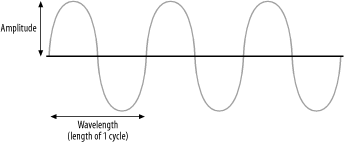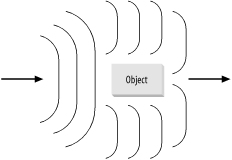1.2 Understanding Radio Waves
Most of the wireless technologies mentioned in the last section make use of radio waves. Wi-Fi, GPRS, GPS, and Bluetooth all utilize radio waves to transmit signals.
1.2.1 Radio Wave Basics
Put simply, a radio wave is an electromagnetic wave. It can propagate through a vacuum, air, liquid, or even solid objects. It can be depicted mathematically as a sinusoidal curve as shown in Figure 1-5.
Figure 1-5. A sine wave representing a radio wave

The distance covered by a complete sine wave (a cycle) is known as the wavelength. The height of the wave is called the amplitude . The number of cycles made in a second is known as the frequency. Frequency is measured in Hertz (Hz), also known as cycles per second. So, a 1 Hz signal makes a full cycle once per second. You should be familiar with this unit of measurement: if your new computer operates at 2 GHz, the internal clock of your CPU generates signals at roughly two billion cycles per second.
|
1.2.2 Modulating Radio Waves
The sine wave carries data. To receive the transmission (such as audio or video), a radio wave receiver needs to tune itself to the same frequency as the transmitter. The receiver examines the amplitude or the frequency of the received electromagnetic wave in order to get at the transmitted data.
In the next section, I discuss three ways to carry data using radio waves.
1.2.2.1 Pulse Modulation
Pulse Modulation (PM) works by switching the radio signals ON and OFF (see Figure 1-6). This is similar to sending information using Morse code. The atomic clock set up by the National Institute of Standards and Technology in Fort Collins, Colorado uses PM to synchronize remote clocks and watches.
Figure 1-6. Pulse Modulation (PM)

1.2.2.2 Amplitude Modulation
Amplitude Modulation (AM), as the name implies, works by varying the amplitude of the sine waves (see Figure 1-7). Different amplitudes represent different values. The most famous example use of AM is in your radio.
Figure 1-7. Amplitude Modulation (AM)

1.2.2.3 Frequency Modulation
Frequency Modulation (FM) varies the frequency (the wavelength) of the sine waves (see Figure 1-8). The frequency of the sine waves changes slightly to represent different values. FM is commonly used in radios as well as popular household items such as televisions and cordless phones. Your mobile phone also uses FM.
Figure 1-8. Frequency Modulation (FM)

1.2.3 Radio Frequency Spectrum
To regulate the use of the various radio frequencies, the Federal Communications Commission (FCC) in the United States determines the allocation of frequencies for various uses. Table 1-2 shows some of the bands defined by the FCC (see http://www.fcc.gov/oet/spectrum/table/fcctable.pdf).
|
Frequency |
Band |
|---|---|
|
10 kHz to 30 kHz |
Very Low Frequency (VLF) |
|
30 kHz to 300 kHz |
Low Frequency (LF) |
|
300 kHz to 3 MHz |
Medium Frequency (MF) |
|
3 MHz to 30 MHz |
High Frequency (HF) |
|
30 MHz to 328.6 MHz |
Very High Frequency (VHF) |
|
328.6 MHz to 2.9 GHz |
Ultra High Frequency (UHF) |
|
2.9 GHz to 30 GHz |
Super High Frequency (SHF) |
|
30 GHz and above |
Extremely High Frequency (EHF) |
Table 1-3 shows some example of radio devices and their frequency ranges.
|
Frequency range |
Device |
|---|---|
|
535 kHz to 1.705 MHz |
AM radio |
|
5.95 MHz to 26.1 MHz |
Short wave radio |
|
54 to 88 MHz |
Television stations (channels 2 through 6) |
|
88 MHz to 108 MHz |
FM radio |
|
174 to 216 MHz |
Television stations (channels 7 through 13) |
|
~ 900 MHz, ~ 2.4 GHz, ~ 5 GHz |
Cordless phones |
|
1.2276 and 1.57542 GHz |
Global Positioning Systems (GPS) |
You can get a more detailed frequency allocation chart from http://www.ntia.doc.gov/osmhome/allochrt.pdf. The following is a conversion list that should help you understand this chart:
1 kiloHertz (kHz) = 1000 Hz
1 MegaHertz (MHz) = 1000 kHz
1 GigaHertz (GHz) = 1000 MHz
1.2.4 Radio Wave Behavior
Radio waves, like light waves, exhibit certain characteristics when coming into contact with objects. Here are some of the possible behaviors.
1.2.4.1 Reflection
Reflection occurs when a radio wave hits an object that is larger than the wavelength of the radio wave (see Figure 1-9). The radio wave is then reflected off the surface.
Figure 1-9. Reflection of a radio wave

1.2.4.2 Refraction
Refraction occurs when a radio wave hits an object of a higher density than its current medium (see Figure 1-10). The radio wave now travels at a different angle. An example would be radio waves propagating through clouds.
Figure 1-10. Refraction of a radio wave

1.2.4.3 Scattering
Scattering occurs when a radio wave hits an object of irregular shape, usually an object with a rough surface area (see Figure 1-11), and the radio wave bounces off in multiple directions.
Figure 1-11. Scattering of a radio wave

1.2.4.4 Absorption
Absorption occurs when a radio wave hits an object that does not cause it to be reflected, refracted, or scattered, so it is absorbed by the object (see Figure 1-12). The radio wave is then lost.
Figure 1-12. Absorption of a radio wave

Radio Interference and AbsorptionRadio waves are subject to interference caused by objects and obstacles in the air. Such obstacles can be concrete walls, metal cabinets, or even raindrops. In general, transmissions made at higher frequencies are more subject to radio absorption (by the obstacles) and larger signal loss. Larger frequencies have smaller wavelengths, and hence signals with smaller wavelengths tend to be absorbed by the obstacles that they collide with. This causes high frequency devices to have a shorter operating range. For devices that transmit data at high frequencies, much more power is needed in order for them to cover the same range as compared to lower frequency transmitting devices. |
1.2.4.5 Diffraction
Sometimes a radio wave will be blocked by objects standing in its path. In this case, the radio wave is broken up and bends around the corners of the object (see Figure 1-13). It is this property that allows radio waves to operate without a visual line of sight.
Figure 1-13. Diffraction of radio waves








